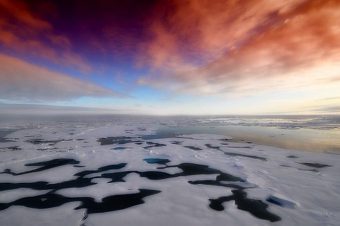
Enormous quantities of toxic mercury are now accumulating in the Arctic tundra as a result of industrial activity and emissions in the temperate parts of the globe, according to a new study from UMass Lowell.
While the presence of high quantities of mercury in the Arctic has been a known fact for awhile now, the source of this mercury was somewhat disputed. The new research shows, though, that airborne mercury from industrial activity elsewhere is the source of most of the mercury now accumulating in the Arctic.
Something that should be realized here is that as the Arctic tundra continues warming, and as the permafrost continues melting, more and more of the mercury that’s accumulating there will be making its way into the Arctic Ocean (which is a comparatively very shallow ocean as compared to the others). As this happens, and as mercury levels in the Arctic Ocean rise, the wildlife and the fisheries of the region are going to be greatly affected.
As it is, and as explained by Professor Daniel Obrist, chairman of UMass Lowell’s Department of Environmental, Earth and Atmospheric Sciences: “This mercury from the tundra soil explains half to two-thirds of the total mercury input into the Arctic Ocean.”
This relates to between 50 to 85 tons of mercury flowing into the Arctic Ocean every year from tundra soil.
Commenting on the neurological and cardiovascular problems accompanying mercury exposure, Obrist stated: “Mercury has high exposure levels in northern wildlife, such as beluga whales, polar bears, seals, fish, eagles, and other birds. It also affects human populations, particularly the Inuit, who rely on traditional hunting and fishing.”
As an adjunct to that, I came across some research a while back that explored a possible link between the increasing prevalence of what appear to be developmental disorders (like “autism,” etc.) amongst some whale populations and increasingly levels of heavy metal pollution in the oceans. While the link isn’t definitive (as of now), it shouldn’t be too surprising to find out that increasing mercury pollution in the oceans may be dumbing down large-brained animals such as whales and dolphins.
The press release for the study provides more: “Obrist recently completed two years of field research in the tundra, tracking the origin and path of mercury pollution. Working from an observation site in Alaska north of Brooks Range, he and an international group of scientists identified that gaseous mercury in the atmosphere is the source of 70% of the pollutant that finds its way into the tundra soil. In contrast, airborne mercury that is deposited on the ground through rain or snow — a more frequent focus of other studies — accounts for just 2% of the mercury deposits in the region, Obrist’s team found. The new research is the most comprehensive investigation on how mercury is deposited in the Arctic.”
There’s also an overview of the process whereby mercury accumulates in the Arctic tundra: “The dominant source of mercury pollution in the atmosphere is hundreds of tons of the element that are emitted each year through the burning of coal, mining and other industrial processes across the globe. This gaseous mercury is lofted to the Arctic, where it is absorbed by plants in a process similar to how they take up carbon dioxide. Then, the mercury is deposited in the soil when the plants shed leaves or die. As a result, the tundra is a significant repository for atmospheric mercury being emitted by industrialized regions of the world.”
So, here’s yet another reason why people are mistaken who argue that as the climate continues warming, everyone and everything (agriculture, industry, etc.) can simply move northwards. The Arctic has growing problems of its own — even when one doesn’t take the region’s very poor quality “soils” or extreme seasons into account — and it’s apparent that intensive human inhabitation of the region is unrealistic.
To go over that point one more time: Despite rhetoric and popular fantasies to the contrary, as anthropogenic climate change begins making many parts of the world mostly uninhabitable (the Middle East, North Africa, parts of Southern Europe, the American southwest, etc.), the displaced peoples won’t simply be able to move to Canada, Siberia, and Northern Europe, and carry on as before. The carrying capacities of the regions in question just aren’t high for that to happen. This is without even taking into consideration the growing pollution problems there, the collapsing fisheries, or the fact that resource problems will be bearing down by then as well. Or cultural and social problems, for that matter.
The findings of the new work are detailed in a paper published in the July 13 edition of the journal Nature.
Source: cleantechnica.com




